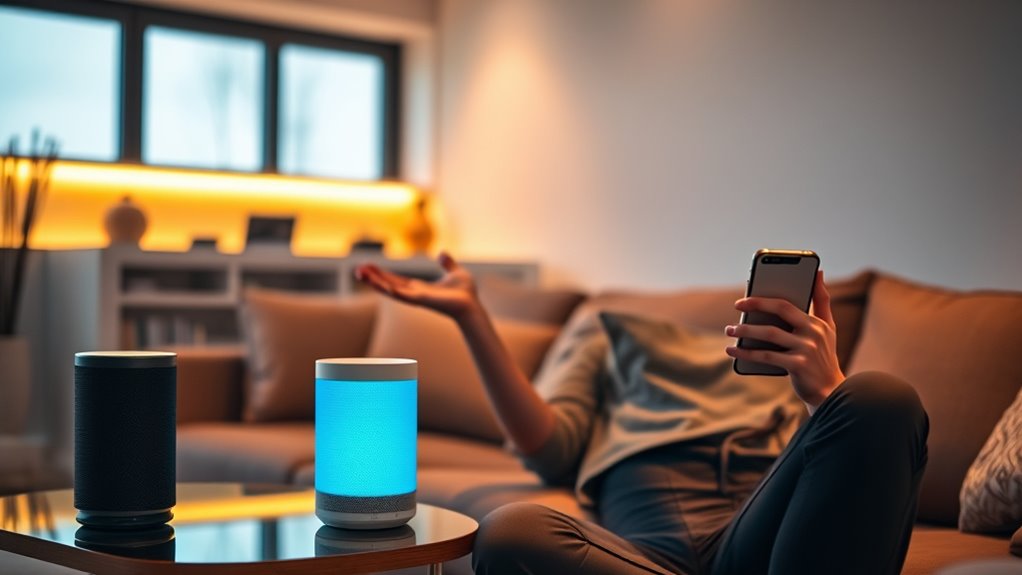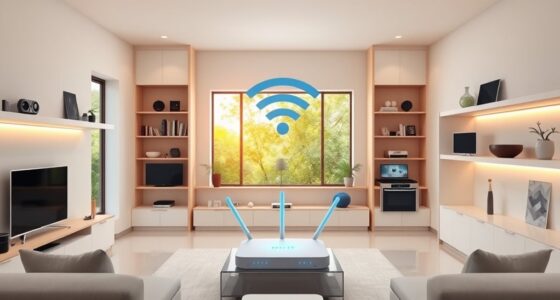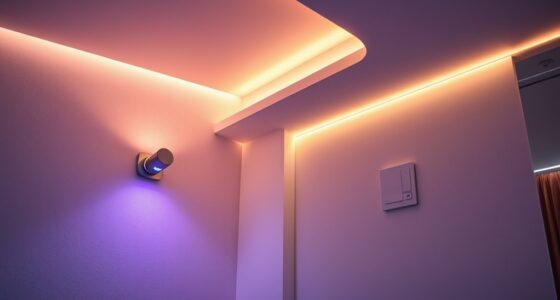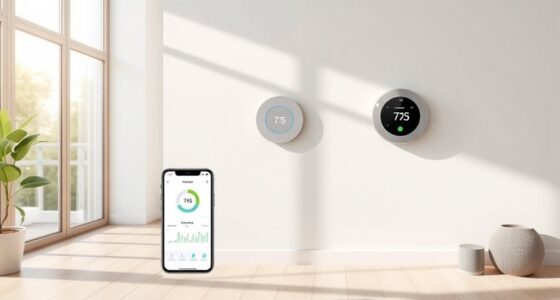Choosing between voice and app control depends on what matters most to you. Voice offers hands-free, quick, and natural interaction once set up, perfect for everyday tasks when your hands are full or you want convenience. Apps provide detailed customization and fine-tuning, ideal for precise control and troubleshooting. Combining both gives you the best of both worlds. To discover how to optimize your smart home with these options, keep exploring the options available.
Key Takeaways
- Voice control offers hands-free, quick operation, ideal for immediate tasks and multitasking scenarios.
- App control provides detailed customization, scheduling, and troubleshooting for precise device management.
- Proper setup is essential for effective voice command recognition and smooth smart home operation.
- Combining voice and app control maximizes convenience and customization, enhancing overall smart home experience.
- User preference influences whether they prioritize effortless voice commands or detailed app-based control.
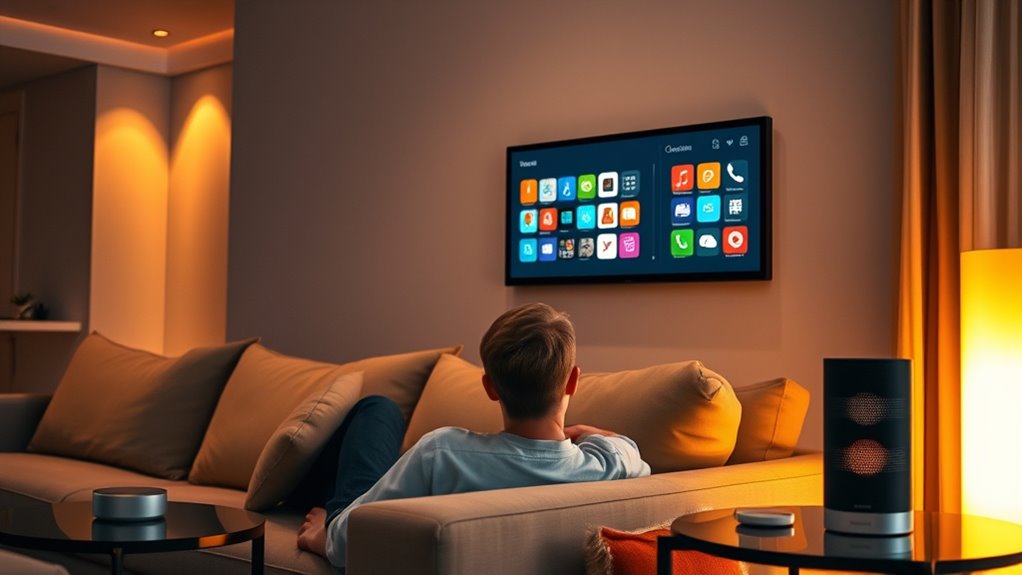
When it comes to controlling smart devices, you might wonder whether voice commands or app control offers a better experience. Both methods have their strengths, but understanding how they work can help you decide which suits your lifestyle best. If you prefer hands-free convenience, voice control through a smart speaker integration is hard to beat. With a simple command, you can turn on lights, adjust thermostats, or play music without even lifting a finger. Smart speaker integration makes controlling your smart home feel seamless and natural. You just speak your request, and your devices respond almost instantly. This ease of use is especially helpful when your hands are full or when you’re lounging on the sofa.
Voice control with a smart speaker offers seamless, hands-free convenience for your smart home.
However, setting up voice control isn’t always straightforward. Manual device setup is a vital step that can seem intimidating at first. You need to connect each device to your Wi-Fi network, ensure compatibility with your smart speaker, and configure routines or preferences. Once completed, though, the process becomes more intuitive and quick to operate. In fact, many smart speakers now support multiple devices, allowing you to create a centralized voice command system that controls everything from lights to security cameras. Still, if your devices aren’t set up properly during the manual setup phase, voice commands might not work as smoothly as you’d like. Proper initial setup guarantees your smart speaker recognizes commands accurately and responds promptly.
While app control offers precision and detailed customization, it can be less immediate than voice commands. Using an app, you can fine-tune settings, schedule actions, or check device status with a few taps. Sometimes, this is the better approach when you want to guarantee everything is configured exactly as you want it. Plus, apps often provide more detailed control options for advanced users. But if you’re looking for rapid, effortless control, voice commands tend to be more convenient—once everything is properly set up. Additionally, understanding the importance of high-quality projectors can enhance your overall smart home experience, especially when integrating entertainment systems.
Ultimately, the choice depends on your preferences and your home’s setup. If you enjoy quick, hands-free control, investing time in smart speaker integration and manual device setup is worthwhile. On the other hand, if you prefer detailed management and troubleshooting, app control can offer the depth you need. Many smart homes benefit from combining both approaches, allowing you to switch between voice commands for everyday tasks and app control for detailed adjustments. Either way, understanding how each method works helps you create a more responsive, efficient smart home environment tailored to your needs.
Frequently Asked Questions
Can Both Control Methods Be Used Simultaneously?
Yes, you can use both control methods simultaneously. This allows you to enjoy voice consistency, where commands are easily understood, and app customization, giving you tailored settings. You might use voice commands for quick adjustments and the app for detailed control. Combining both enhances your smart home experience, offering flexibility and convenience, so you don’t have to stick to just one method.
Which Control Method Offers Better Privacy and Security?
When considering control methods, you might wonder which offers better privacy and security. Voice control can raise privacy concerns because it’s always listening and could be vulnerable to security risks if not properly protected. App control typically provides more control over your data, with clearer security measures. Ultimately, choosing a system with strong encryption and regular updates helps minimize security risks, giving you peace of mind about your smart home’s safety.
Are There Specific Devices That Only Support One Method?
Some smart devices support only one control method due to device compatibility and integration challenges. For example, certain older devices may only work via app control because they lack voice assistant compatibility. Conversely, newer devices often support both voice and app control for flexibility. Before purchasing, check the device specifications to confirm it aligns with your preferred control method, avoiding frustrations caused by limited compatibility or integration issues.
How Do Updates Affect Voice and App Control Functionality?
Like Pandora’s box, updates can refresh or disrupt your smart home. When your devices get updates, they might improve or sometimes break voice compatibility and app synchronization. You’ll want to check release notes, as some updates enhance voice commands or app features, while others might cause hiccups. Staying current guarantees smooth control, but it’s wise to wait for feedback from others prior to installing major updates, keeping your smart home humming seamlessly.
What Are the Costs Associated With Each Control Option?
When considering control options, you’ll find a clear cost comparison. App control often involves lower upfront costs since many apps are free, but premium features or subscriptions can add up. Voice control might require additional smart speakers or hubs, increasing initial expenses. Affordability factors include device compatibility and ongoing costs like updates or subscriptions. Overall, app control tends to be more budget-friendly, but your choice depends on your preferences and specific setup needs.
Conclusion
Ultimately, whether you prefer voice or app control, both methods streamline your smart home experience. Some experts argue voice commands feel more natural, but apps offer precision and control. Surprisingly, studies suggest that integrating both can create a more seamless environment, challenging the idea that one is inherently better. By combining these technologies, you might find that your home becomes not only smarter but also more intuitive, proving that the best approach is often a balanced one.
